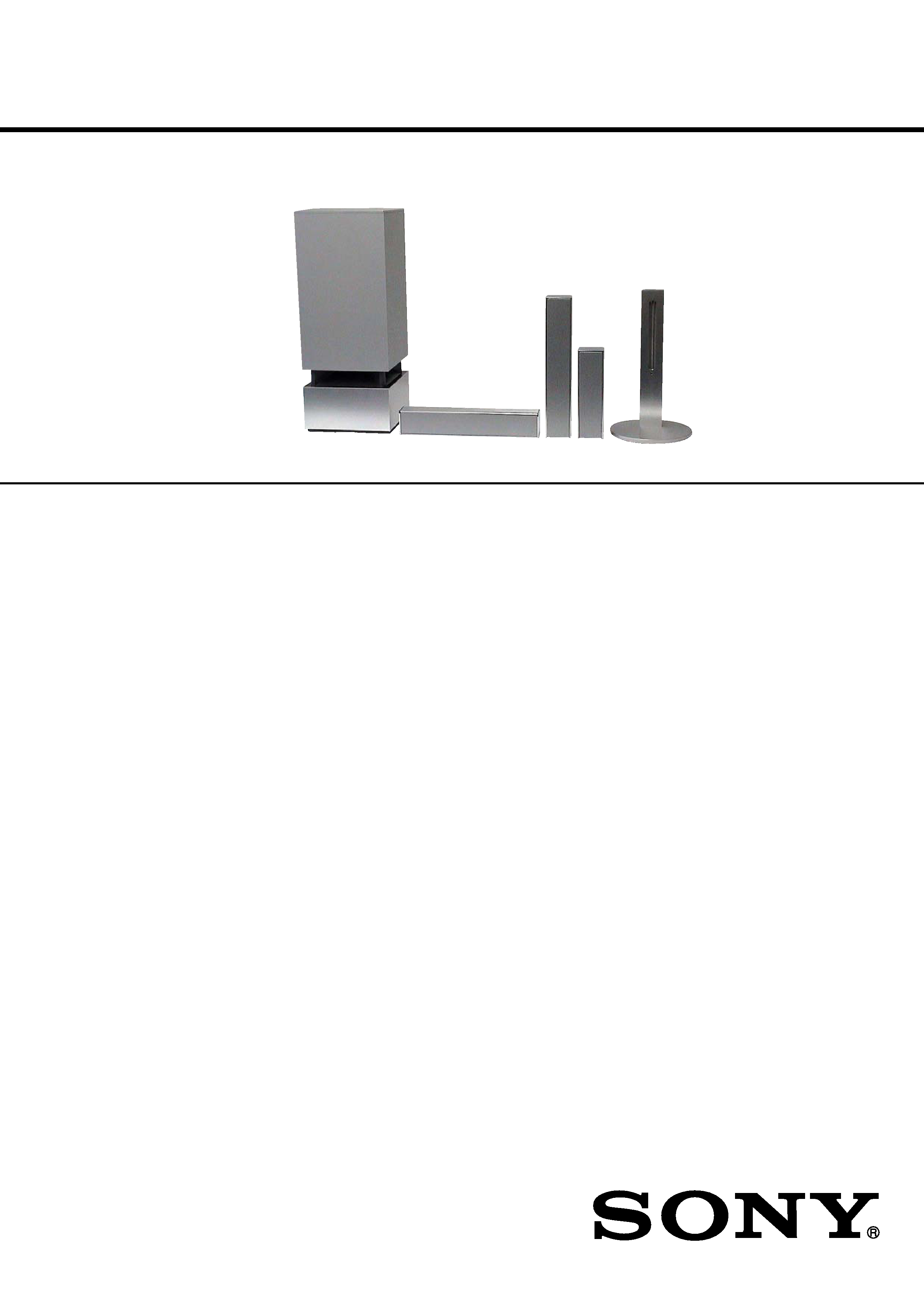
SERVICE MANUAL
SPEAKER SYSTEM
US Model
E Model
Australian Model
SA-WSLF10/
SS-CTL10/TSL10/TSL11
Ver. 1.0 2005.03
SPECIFICATIONS
9-879-563-01
2005C05-1
© 2005.03
Sony Corporation
Audio Group
Published by Sony Engineering Corporation
Continued on next page
· SA-WSLF10 is the subwoofer in DAV-LF10.
· SS-CTL10 is the center speaker in DAV-LF10.
· SS-TSL10 is the front speaker in DAV-LF10.
· SS-TSL11 is the surround speaker in DAV-LF10.
This system incorporates with Dolby* Digital and Dolby Pro Logic (II)
adaptive matrix surround decoder and the DTS** Digital Surround
System.
* Manufactured under license from Dolby Laboratories.
"Dolby", "Pro Logic", and the double-D symbol are trademarks of
Dolby Laboratories.
**Manufactured under license from Digital Theater Systems, Inc.
"DTS", "DTS-ES", and "DTS Digital Surround" are trademarks of
Digital Theater Systems, Inc.
Tuner section SA-WSLF10
System
PLL quartz-locked digital
synthesizer system
FM tuner section
Tuning range
North American models:
87.5 108.0 MHz
(100 kHz step)
Other models:
87.5 108.0 MHz
(50 kHz step)
Antenna (aerial)
FM wire antenna (aerial)
Antenna (aerial) terminals 75 ohms, unbalanced
Intermediate frequency
10.7 MHz
AM tuner section
Tuning range
North American models:
530 1,710 kHz (with the
interval set at 10 kHz)
531 1,710 kHz (with the
interval set at 9 kHz)
Other models:
530 1,710 kHz (with the
interval set at 10 kHz)
531 1,602 kHz (with the
interval set at 9 kHz)
Antenna (aerial)
AM loop antenna (aerial)
Intermediate frequency
450 kHz
Video section SA-WSLF10
Outputs
Video: 1 Vp-p 75 ohms
S video:
Y: 1 Vp-p 75 ohms
C: 0.286 Vp-p 75 ohms
COMPONENT:
Y: 1 Vp-p 75 ohms
PB/CB, PR/CR: 0.7 Vp-p
75 ohms
Inputs
Video: 1 Vp-p 75 ohms
Speakers
Fro
For the US model
nt SS-TSL10
Speaker system
Two-way bass reflex,
magnetically shielded
Speaker unit
50 mm (2 inches) dia. cone
type
× 2, 25 mm (1 inch)
dia. balance-dome-type
tweeter
Rated impedance
4 ohms
Dimensions (approx.)
68
× 380 × 53 mm (2 3/
4 ×
15
× 2 1/
8 inches) (w/h/d)
220
× (398 530) × 220
mm (8 3/4 × (15
3/
4 20
7/
8)
× 8 3/
4 inches) (w/h/d) with
stand
AUDIO POWER SPECIFICATIONS
POWER OUTPUT AND
TOTAL HARMONIC
DISTORTION:
With 4 ohm loads, both
channels driven, from
200 20,000 Hz; rated
65 watts per channel
minimum RMS power,
with no more than 0.7 %
total harmonic distortion
from 250 milli watts to
rated output.
Amplifier section SA-WSLF10
Stereo mode (rated)
86 W + 86 W (4 ohms at
1 kHz, THD 10 %)
Surround mode (reference) music power output
Front:
86 W (each)
(with SS-TSL10)
Center*:
86 W
(with SS-CTL10)
Surround*:
86 W
(with SS-TSL11)
Subwoofer*:
85 W
× 2
(with SA-WSLF10)
*Depending on the sound field settings and the source,
there may be no sound output.
Inputs
VIDEO/SAT:
Sensitivity: 300 mV
Impedance: 50 kilohms
Phones
Accepts low-and high-
impedance headphones.
SA-WSLF10
SS-CTL10
SS-TSL10 SS-TSL11 STAND ASSY
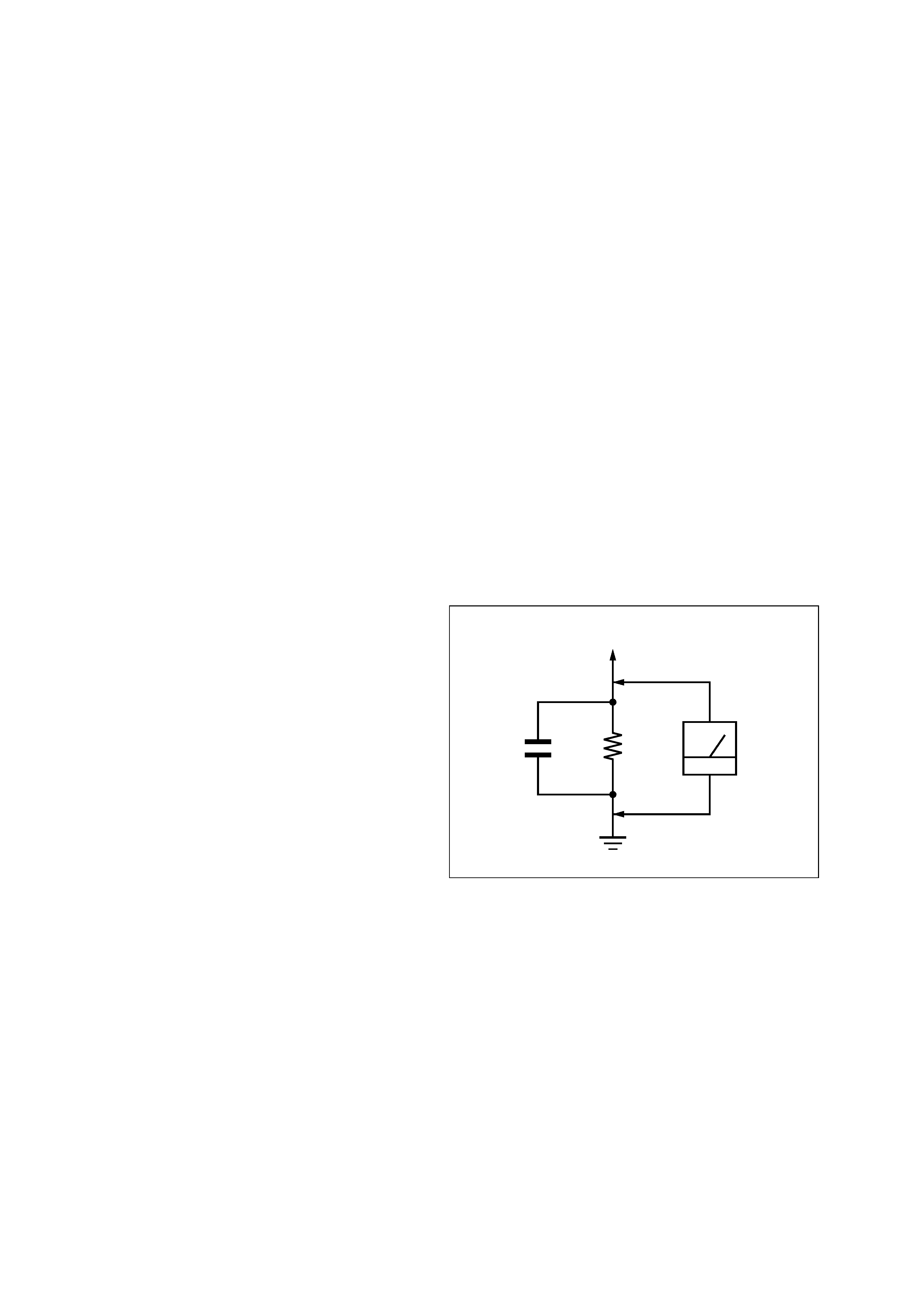
2
SA-WSLF10/SS-CTL10/TSL10/TSL11
SAFETY-RELATED COMPONENT WARNING!!
COMPONENTS IDENTIFIED BY MARK 0 OR DOTTED LINE
WITH MARK 0 ON THE SCHEMATIC DIAGRAMS AND IN
THE PARTS LIST ARE CRITICAL TO SAFE OPERATION.
REPLACE THESE COMPONENTS WITH SONY PARTS WHOSE
PART NUMBERS APPEAR AS SHOWN IN THIS MANUAL OR
IN SUPPLEMENTS PUBLISHED BY SONY.
Mass (approx.)
1.3 kg (2 lb 14 oz)
2.7 kg (6 lb) with stand
Center SS-CTL10
Speaker system
Two-way bass reflex,
magnetically shielded
Speaker unit
50 mm (2 inches) dia. cone
type
×2, 25 mm (1 inch)
dia. balance-dome-type
tweeter
Rated impedance
4 ohms
Dimensions (approx.)
68
× 380 × 53 mm (2 3/
4 ×
15
× 2 1/
8 inches) (w/h/d)
Mass (approx.)
1.3 kg (2 lb 14 oz)
Surround SS-TSL11
Speaker system
Two-way bass reflex,
magnetically shielded
Speaker unit
50 mm (2 inches) dia. cone
type
×2, 25 mm (1 inch)
dia. balance-dome-type
tweeter
Rated impedance
4 ohms
Dimensions (approx.)
68
× 240 × 53 mm (2 3/
4 ×
9 1/2 × 2
1/
8 inches) (w/h/d)
Mass (approx.)
1.0 kg (2 lb 4 oz)
Subwoofer SA-WSLF10
Speaker system
Bass reflex
Speaker unit
180 mm (7 1/8 inches) dia.
cone type
Rated impedance
4 ohms
× 2
Dimensions (approx.)
241
× 606 × 241 mm
(9 1/2 × 23
7/
8 × 9
1/
2
inches) (w/h/d)
Mass (approx.)
14 kg (30 lb 14 oz)
Power requirements
North American models:
120 V AC, 60 Hz
Taiwan model:
120 V AC, 50/60 Hz
Other models:
220-240 V AC, 50/60 Hz
Power consumption
120 W
0.3 W (at the Power Saving
mode)
Design and specifications are subject to change
without notice.
Notes on chip component replacement
· Never reuse a disconnected chip component.
· Notice that the minus side of a tantalum capacitor may be
damaged by heat.
SAFETY CHECK-OUT
After correcting the original service problem, perform the following
safety check before releasing the set to the customer:
Check the antenna terminals, metal trim, "metallized" knobs, screws,
and all other exposed metal parts for AC leakage.
Check leakage as described below.
LEAKAGE TEST
The AC leakage from any exposed metal part to earth ground and
from all exposed metal parts to any exposed metal part having a
return to chassis, must not exceed 0.5 mA (500 microamperes.).
Leakage current can be measured by any one of three methods.
1. A commercial leakage tester, such as the Simpson 229 or RCA
WT-540A. Follow the manufacturers' instructions to use these
instruments.
2. A battery-operated AC milliammeter. The Data Precision 245
digital multimeter is suitable for this job.
3. Measuring the voltage drop across a resistor by means of a
VOM or battery-operated AC voltmeter. The "limit" indication
is 0.75 V, so analog meters must have an accurate low-voltage
scale. The Simpson 250 and Sanwa SH-63Trd are examples
of a passive VOM that is suitable. Nearly all battery operated
digital multimeters that have a 2 V AC range are suitable. (See
Fig. A)
Fig. A.
Using an AC voltmeter to check AC leakage.
1.5 k
0.15
µF
AC
voltmeter
(0.75 V)
To Exposed Metal
Parts on Set
Earth Ground
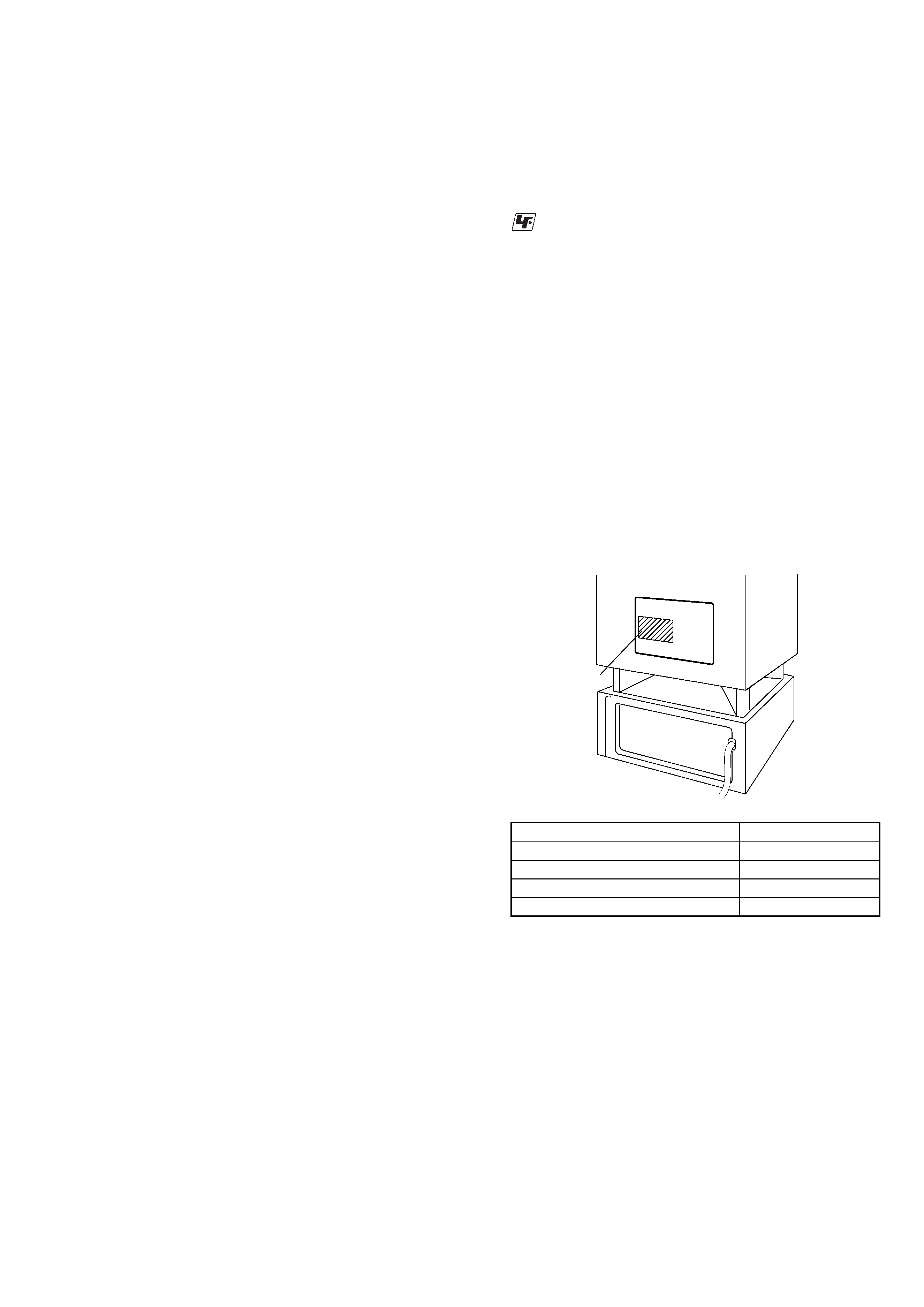
3
SA-WSLF10/SS-CTL10/TSL10/TSL11
TABLE OF CONTENTS
1.
SERVICING NOTES ............................................... 3
2.
GENERAL ................................................................... 6
3.
DISASSEMBLY ......................................................... 7
4.
ELECTRICAL ADJUSTMENT ............................ 8
5.
DIAGRAMS
5-1.
Block Diagram AUDIO DSP Section ........................
9
5-2.
Block Diagram AUDIO Section ................................ 10
5-3.
Block Diagram
VIDEO/POWER SUPPLY Section ........................... 11
5-4.
Printed Wiring Board
MAIN Board (Component Side) ............................... 14
5-5.
Printed Wiring Board
MAIN Board (Conductor Side) ................................. 15
5-6.
Schematic Diagram MAIN Board (1/4) .................... 16
5-7.
Schematic Diagram MAIN Board (2/4) .................... 17
5-8.
Schematic Diagram MAIN Board (3/4) .................... 18
5-9.
Schematic Diagram MAIN Board (4/4) .................... 19
5-10. Printed Wiring Board
S-MASTER Board (Component Side) ...................... 20
5-11. Printed Wiring Board
S-MASTER Board (Conductor Side) ........................ 21
5-12. Schematic Diagram S-MASTER Board (1/4) ........... 22
5-13. Schematic Diagram S-MASTER Board (2/4) ........... 23
5-14. Schematic Diagram S-MASTER Board (3/4) ........... 24
5-15. Schematic Diagram S-MASTER Board (4/4) ........... 25
5-16. Printed Wiring Board TX Board ................................ 26
5-17. Schematic Diagram TX Board .................................. 27
5-18. Printed Wiring Board VIDEO I/O Board .................. 28
5-19. Schematic Diagram VIDEO I/O Board ..................... 29
5-20. Printed Wiring Boards
COMPONENT/SPK-OUT Boards ............................ 30
5-21. Schematic Diagram
COMPONENT/SPK-OUT Boards ............................ 31
5-22. Printed Wiring Boards POWER SUPPLY Section .... 32
5-23. Schematic Diagram POWER SUPPLY Section ........ 33
6.
EXPLODED VIEWS
6-1.
Overall Section (SA-WSLF10) ....................................... 44
6-2.
AMP Assy Section (SA-WSLF10) .................................. 45
6-3.
MAIN Board Section (SA-WSLF10) .............................. 46
6-4.
SS-CTL10/TSL10/TSL11 Section .................................. 47
6-5.
Stand Section ................................................................... 48
7.
ELECTRICAL PARTS LIST ................................ 49
SECTION 1
SERVICING NOTES
UNLEADED SOLDER
Boards requiring use of unleaded solder are printed with the lead-
free mark (LF) indicating the solder contains no lead.
(Caution: Some printed circuit boards may not come printed with
the lead free mark due to their particular size)
: LEAD FREE MARK
Unleaded solder has the following characteristics.
· Unleaded solder melts at a temperature about 40 °C higher
than ordinary solder.
Ordinary soldering irons can be used but the iron tip has to be
applied to the solder joint for a slightly longer time.
Soldering irons using a temperature regulator should be set to
about 350 °C.
Caution: The printed pattern (copper foil) may peel away if
the heated tip is applied for too long, so be careful!
· Strong viscosity
Unleaded solder is more viscou-s (sticky, less prone to flow)
than ordinary solder so use caution not to let solder bridges
occur such as on IC pins, etc.
· Usable with ordinary solder
It is best to use only unleaded solder but unleaded solder may
also be added to ordinary solder.
MODEL IDENTIFICATION
MODEL
PART No.
US model
2-590-864-0[]
Taiwan model
2-590-866-0[]
Singapore model
2-590-867-0[]
Australian model
2-591-603-0[]
Part No.
Rear View
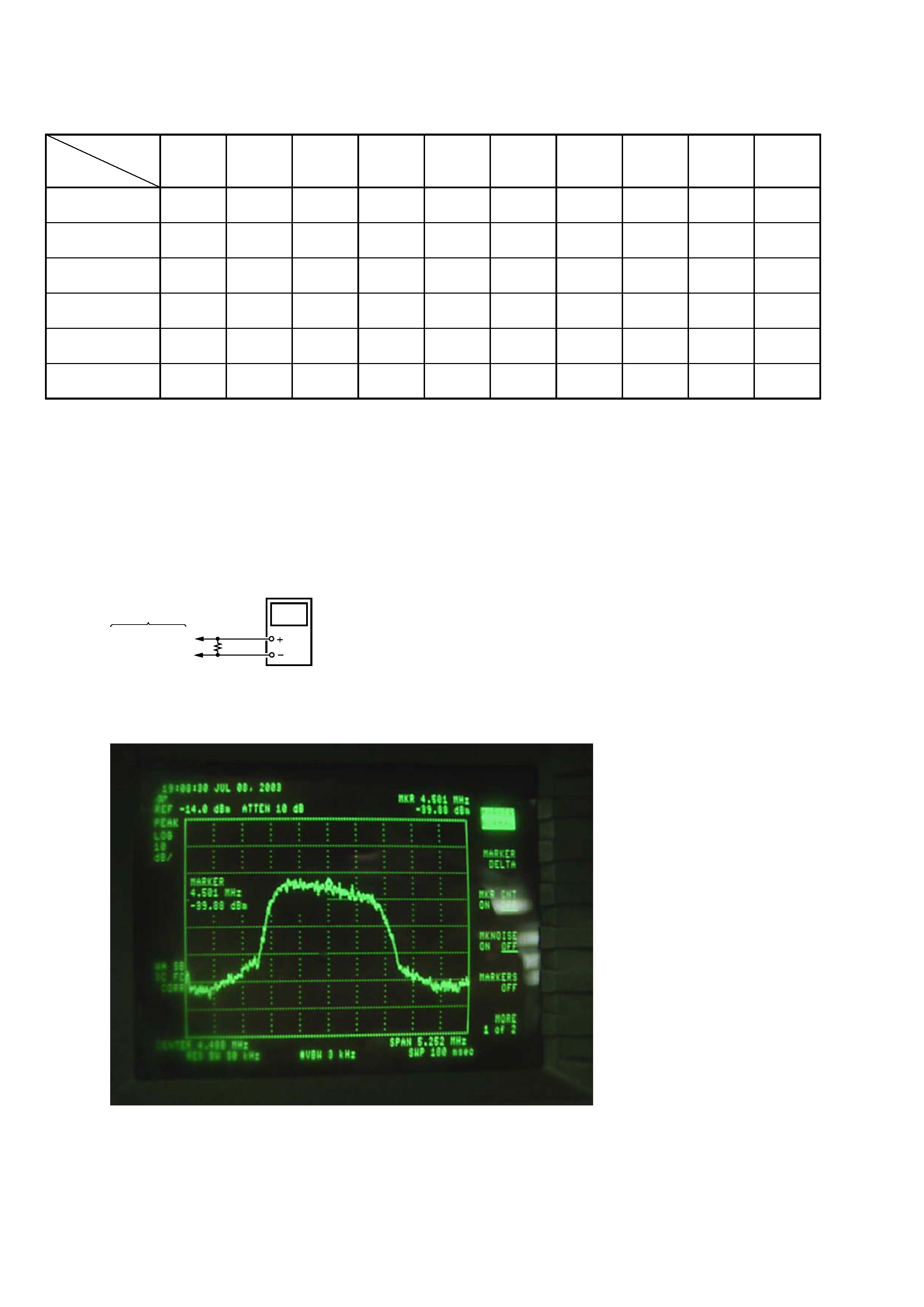
4
SA-WSLF10/SS-CTL10/TSL10/TSL11
THE CHECK METHOD OF THE OUTPUT SIGNAL FROM TX BOARD
Procedure:
1. A spectrum analyzer is connected to pin 1 and pin 2 of the output connector (CN803) of TX board.
2. Confirm that it is spectrum as shown in a figure with the spectrum analyzer. It is normal if the signal of a 3MHz to 6MHz zone (a center
is 4.5MHz) can be checked.
digital
voltmeter
10
(0.5%)
TX board
CN803 pin 1
pin 2
3. When the output signal from TX board is normal, pin 8 (SDATA), pin 4 (LRCKO) and pin 5 (BCKO) of the input signal connector
(CN801) are investigated.
Super audio CD/
DVD player :
HCD-LF10
Units required for
operation
check
Super audio CD/
DVD player : HCD-LF10
Sub woofer :
SA-WSLF10
Front speaker :
SS-TSL10
Center speaker :
SS-CTL10
Surround speaker :
SS-TSL11
Remote commander :
RM-SP320
Unit.
need to
checking
a
a
a
Center
speaker :
SS-CTL10
a
a
Sub woofer :
SA-WSLF10
a
a
a
a
Remote
commander :
RM-SP320
IR transmitter :
DIR-T1
Remote
sensor :
DIR-R4
Surround
amplifier :
TA-SB500WR
IR receiver :
DIR-R1
a
a
a
a
a
a
a
aaaa
a
Surround
speaker :
SS-TSL11
a*1
Front speaker :
SS-TSL10
a*1
a*2
*1 Only the defective unit. *2 Either one of them.
Units with a mark: The units that are required for the system operation check during repair service
However, there can be a case that some units of the system need to not be brought into repair shop depending on the unit. that became defective.
· The units that are required for the system operation check during repair service
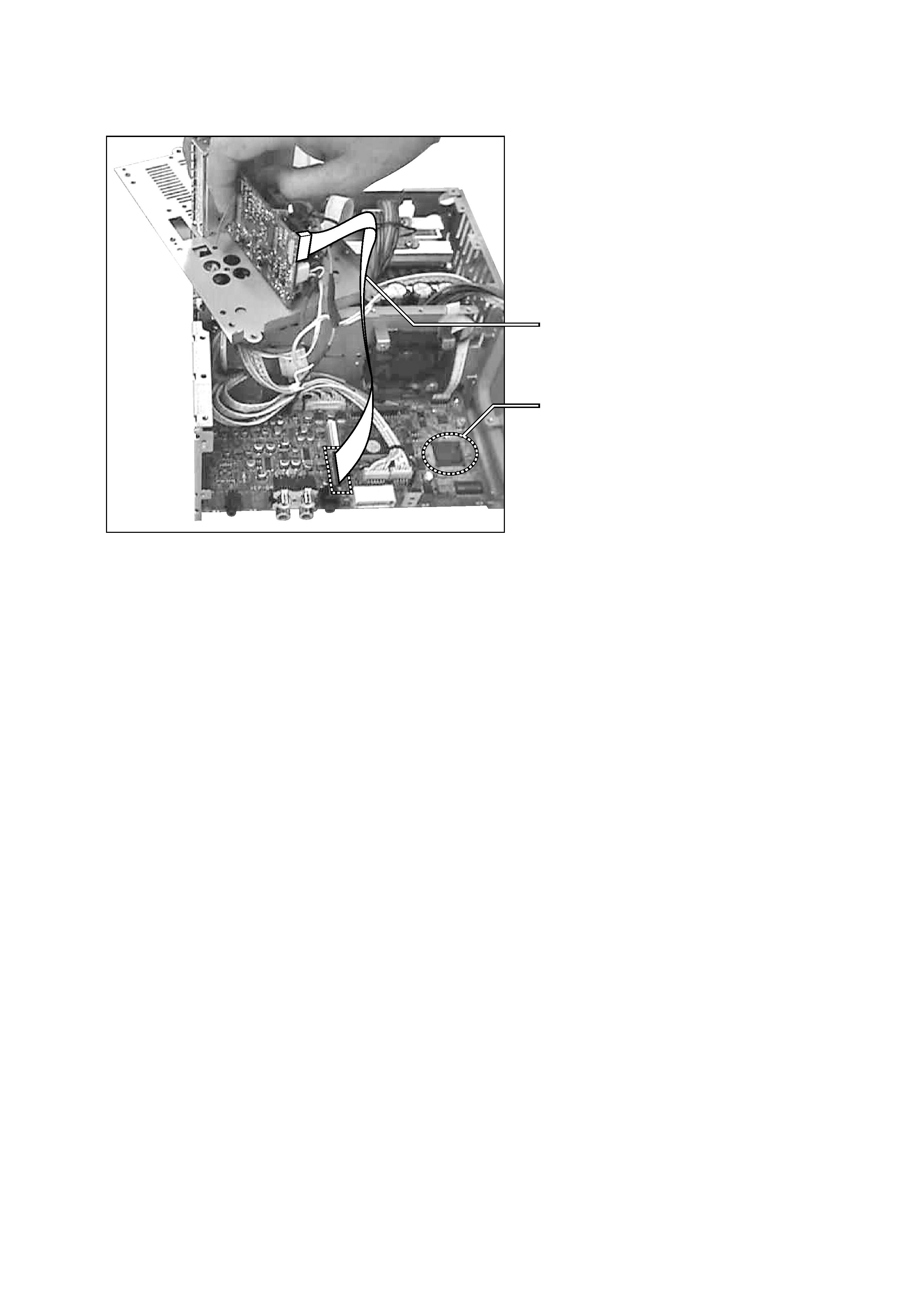
5
SA-WSLF10/SS-CTL10/TSL10/TSL11
Connect the MAIN board and the VIDEO I/O board
using the extension cable and check the MAIN board.
J-2501-245-A
(1mm/23P/L300)
IC525 on the MAIN board
SERVICING POSITION (MAIN Board)
CAUTION:
Keep your eyes 10 cm or more away from the infrared laser unit (DIR-T1).
Do not view directly the laser beam.
